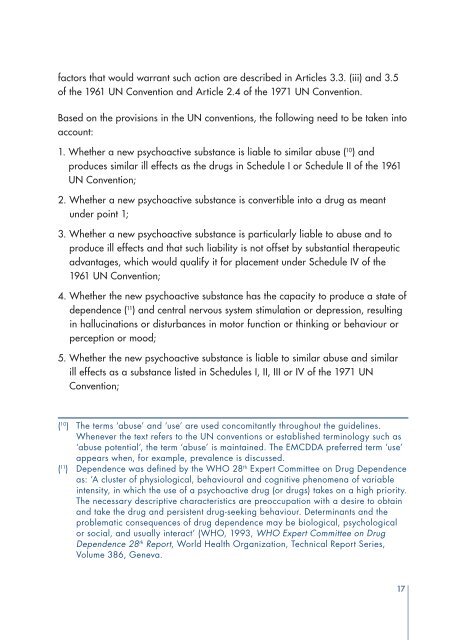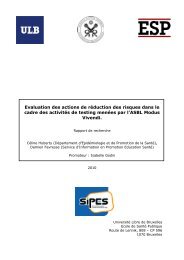Risk assessment of new psychoactive substances - EMCDDA - Europa
Risk assessment of new psychoactive substances - EMCDDA - Europa
Risk assessment of new psychoactive substances - EMCDDA - Europa
- No tags were found...
Create successful ePaper yourself
Turn your PDF publications into a flip-book with our unique Google optimized e-Paper software.
factors that would warrant such action are described in Articles 3.3. (iii) and 3.5<strong>of</strong> the 1961 UN Convention and Article 2.4 <strong>of</strong> the 1971 UN Convention.Based on the provisions in the UN conventions, the following need to be taken intoaccount:1. Whether a <strong>new</strong> <strong>psychoactive</strong> substance is liable to similar abuse ( 10 ) andproduces similar ill effects as the drugs in Schedule I or Schedule II <strong>of</strong> the 1961UN Convention;2. Whether a <strong>new</strong> <strong>psychoactive</strong> substance is convertible into a drug as meantunder point 1;3. Whether a <strong>new</strong> <strong>psychoactive</strong> substance is particularly liable to abuse and toproduce ill effects and that such liability is not <strong>of</strong>fset by substantial therapeuticadvantages, which would qualify it for placement under Schedule IV <strong>of</strong> the1961 UN Convention;4. Whether the <strong>new</strong> <strong>psychoactive</strong> substance has the capacity to produce a state <strong>of</strong>dependence ( 11 ) and central nervous system stimulation or depression, resultingin hallucinations or disturbances in motor function or thinking or behaviour orperception or mood;5. Whether the <strong>new</strong> <strong>psychoactive</strong> substance is liable to similar abuse and similarill effects as a substance listed in Schedules I, II, III or IV <strong>of</strong> the 1971 UNConvention;( 10 ) The terms ‘abuse’ and ‘use’ are used concomitantly throughout the guidelines.Whenever the text refers to the UN conventions or established terminology such as‘abuse potential’, the term ‘abuse’ is maintained. The <strong>EMCDDA</strong> preferred term ‘use’appears when, for example, prevalence is discussed.( 11 ) Dependence was defined by the WHO 28 th Expert Committee on Drug Dependenceas: ‘A cluster <strong>of</strong> physiological, behavioural and cognitive phenomena <strong>of</strong> variableintensity, in which the use <strong>of</strong> a <strong>psychoactive</strong> drug (or drugs) takes on a high priority.The necessary descriptive characteristics are preoccupation with a desire to obtainand take the drug and persistent drug-seeking behaviour. Determinants and theproblematic consequences <strong>of</strong> drug dependence may be biological, psychologicalor social, and usually interact’ (WHO, 1993, WHO Expert Committee on DrugDependence 28 th Report, World Health Organization, Technical Report Series,Volume 386, Geneva.17







